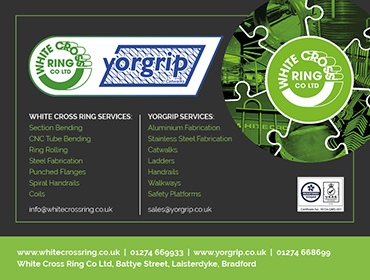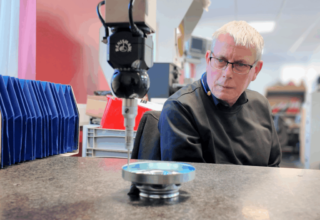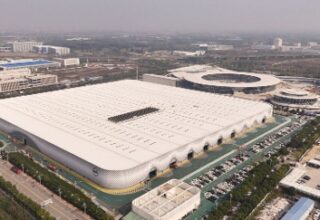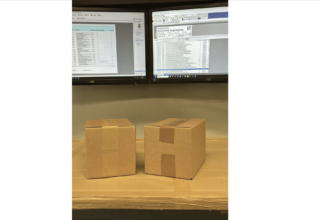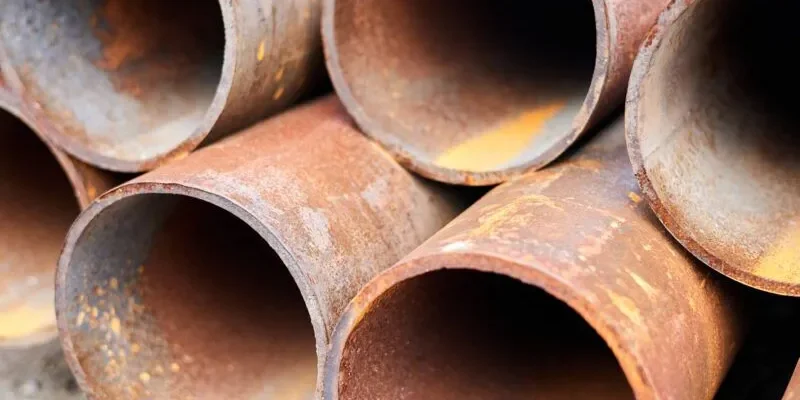
Structural steel is a staple of construction, manufacturing, and numerous other industries. Why? Because it’s a versatile material that does a fantastic job. That said, one of the biggest challenges associated with steel is its tendency to corrode.
Baker Steel Trading Ltd delves into the root causes of steel corrosion, explores various prevention methods, and suggests effective solutions to prevent it. Armed with this knowledge, you will be able to extend the lifespan of steel structures and lower maintenance costs.
CAUSES OF STEEL CORROSION
CHEMICAL CAUSES
Oxygen
Steel corrosion is a major concern in many industries, and oxygen is a crucial component in the process. When steel is exposed to water, the oxygen in the water reacts with the iron in the steel, forming iron oxide, commonly known as rust.
It is essential to protect steel structures from exposure to water and other corrosive substances to prevent or slow down this process. Coatings, inhibitors, and regular maintenance can help reduce the corrosion rate and increase the steel’s lifespan.
Chlorides
Chloride ions in seawater and de-icing salts can break down the protective oxide layer on steel surfaces. This results in faster corrosion, particularly in coastal areas and regions that heavily use de-icing salts in the winter.
Carbon dioxide
Carbon dioxide, a gas naturally present in the atmosphere, can dissolve in water, forming carbonic acid. This weak acid can react with steel, causing corrosion over time. This type of corrosion is commonly observed in pipelines and structures exposed to atmospheric carbon dioxide.
The corrosion caused by carbonic acid can be particularly damaging to steel because it can occur even in the absence of oxygen. Additionally, carbon dioxide can lower the pH of the water, making it more acidic and further accelerating the corrosion process.
ENVIRONMENTAL CAUSES
Temperature
The rate of steel corrosion can be significantly impacted by higher temperatures. When the temperature increases, the chemical reactions that cause corrosion tend to occur more rapidly, accelerating the process.
Humidity
High humidity levels can contribute to steel corrosion. This is because the presence of moisture is needed for the corrosion process to occur. When steel is exposed to humid air, the moisture in the air reacts with the metal to form iron oxide, commonly known as rust. Over time, this rust can weaken and degrade the steel, causing structural damage and potentially compromising its integrity.
Pollution
Air pollution, specifically the emission of sulphur dioxide and nitrogen oxides, can contribute to the creation of acid rain which, in turn, can cause corrosion or even expedite the corrosion process of steel structures.
TYPES OF STEEL CORROSION
UNIFORM CORROSION
Uniform corrosion, also referred to as general corrosion, occurs uniformly on the entire surface of the steel. While it is easier to detect than localised corrosion, it is generally considered less severe.
PITTING CORROSION
Pitting corrosion occurs when small, localised areas of the steel surface corrode much faster than the rest of the surface. This type of corrosion can cause severe damage, leading to the formation of small pits, which can weaken the structure and eventually cause failure.
CREVICE CORROSION
Crevice corrosion is a form of localised corrosion typically occurring in narrow gaps or crevices, including those found between two metal surfaces or between a metal surface and a non-metallic material. This type of corrosion is caused by the concentration of corrosive agents within the crevice, which accelerates the rate of corrosion.
GALVANIC CORROSION
Galvanic corrosion occurs when two distinct metals or alloys come into contact and are exposed to a corrosive environment. In such scenarios, the less noble metal serves as an anode and corrodes at a much faster pace, while the more noble metal serves as a cathode and is safeguarded against corrosion.
STRESS CORROSION CRACKING (SCC)
Stress corrosion cracking is a particularly insidious form of corrosion that can occur when steel is subjected to simultaneous tensile stress and exposure to a corrosive environment. This double whammy of stress and corrosion can cause cracks to initiate and propagate, potentially leading to catastrophic failure of the affected material.
PREVENTION METHODS
PROTECTIVE COATINGS
When it comes to preserving steel surfaces, applying protective coatings like paint or galvanising is crucial. These coatings create a physical barrier between the steel and its surrounding environment, effectively preventing or slowing down corrosion.
By reducing the corrosion rate, these coatings can significantly extend the lifespan of steel structures, making them more durable and cost-effective in the long run. Whether it’s for industrial or commercial applications, investing in protective coatings is a smart choice for anyone looking to maintain the integrity and safety of their steel assets.
CORROSION INHIBITORS
Corrosion inhibitors are chemicals that can be introduced to a corrosive environment to impede or halt corrosion. They achieve this by either creating a protective film on the surface of the steel or by obstructing the chemical reactions that trigger corrosion.
CATHODIC PROTECTION
Cathodic protection is a highly effective technique for safeguarding steel structures against corrosion. The process involves making the steel structure the cathode in an electrochemical cell. To achieve this, the steel structure is connected to a more reactive (less noble) metal, which functions as a sacrificial anode and corrodes in place of the steel. This technique ensures that the steel structure remains corrosion-free, providing long-lasting protection.
MATERIAL SELECTION
Selecting the appropriate material for a particular application can greatly minimise the risk of corrosion. Stainless steel, in particular, exhibits greater resistance to corrosion than carbon steel and may be a suitable option for applications exposed to corrosive environments.
SOLUTIONS
INSPECTION AND MAINTENANCE
Regularly inspecting and maintaining steel structures are essential to identify and resolve corrosion problems before they escalate to critical levels. This process involves a thorough cleaning, repairing any damage, and reapplying protective coatings as necessary to ensure the long-term integrity of the structure. By prioritising maintenance, you can mitigate the effects of wear and tear and prolong the lifespan of the steel structure.
REPAIR AND RETROFIT
When steel structures are affected by corrosion, it’s crucial to repair or retrofit them to restore their strength and functionality. This may involve replacing corroded sections, reinforcing weakened areas, or implementing additional corrosion protection measures. By taking these steps, you can ensure that the structure remains safe and durable, even in harsh environments.
CONCLUSION
Steel corrosion is a challenging and expensive issue. However, comprehending its underlying reasons and implementing effective prevention methods can significantly reduce its impact. Selecting appropriate materials, employing protective coatings and corrosion inhibitors, and conducting periodic inspections and maintenance can extend the lifespan of steel structures, ensuring their safety and reliability.









